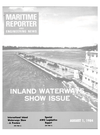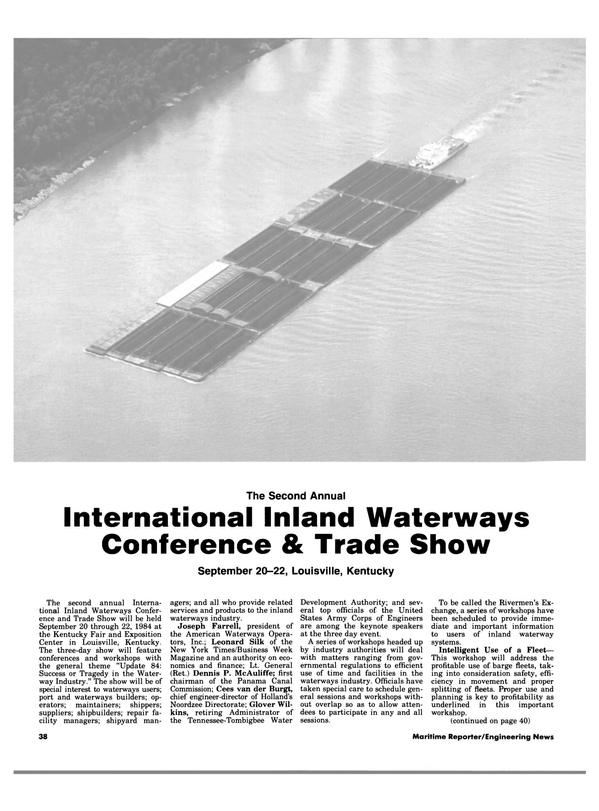
14 MarineSafety Training Courses Detailed In 12 Page Brochure
MarineSafety International (MSI), located in the Marine Air Terminal at LaGuardia Airport in New York City, is offering a total of 14 marine training courses during 1984. The courses are summarized as follows: "Shiphandling and Maneuvering in Restricted Waters," for masters, pilots, chief mates and deck officers. Two to four persons—three to five days. Optional areas of emphasis: pre-command shiphandling, bridge team management, watchkeeping, shiphandling for pilots, harbor piloting and docking.
"Valdez and Prince William Sound," U.S. Coast Guard accredited course for geographic familiarization and VLCC shiphandling.
Five-day course includes USCG radar endorsement if desired.
Two to four persons—three to five days.
"Approaches, Moorings and Breakaways at Single Point Moorings and Storage Vessels," for masters, chief mates, and other deck officers. Various size vessels can be maneuvered and moored in the Loop, Hondo, and similar areas.
Two to three persons for three days; four persons for five days.
"Shiphandling and Piloting in St. Lawrence Seaway," uses two types of seaway vessels—120 miles of difficult sections of the Seaway.
Four persons for five days. Four levels of courses based on trainees' past experience.
"Canal Shiphandling and Piloting in Panama and similar areas," for apprentice to experienced levels.
Lock approaches with oblique and parallel walls. Two to four persons—three to five days.
"Advanced Shiphandling for Naval Officers," two to eight persons— three to five days. Special courses for aviation and surface warfare officers.
"Risk Reduction," shiphandling and maneuvering using both the ship and restricted visibility bridge simulators with concentration on past accident situations. Four to eight persons—five days.
"Radar—ARPA," course for masters and chief mates. The fiveday course includes USCG radar endorsement if desired. Meets forthcoming USCG and IMO requirements for ARPA training.
Two to eight persons—three to five days.
"LNG Cargo Handling Familiarization," for ship's officers, terminal personnel and Coast Guard inspectors— uses LNG cargo-handling simulator. Six to 10 persons—five days.
"Advanced LNG Cargo Handling," for ship's officers who will be responsible for gas handling.
Uses LNG cargo-handling simulator.
Six to eight persons for 10 days.
"Emergency Medical Care at Sea," for shipboard, rig or ashore personnel. Presented by medical personnel, uses D.O.T. "First Responder" outline and is USCG approved.
One to 20 persons—three to five-day course.
"Steam Turbine Power Plant Familiarization," for masters and chief mates. Uses full engine room simulator. Four to eight persons for three days.
"Steam Turbine Power Plant Management," watchstanding and handling emergencies in the full engine room simulator—also includes interactive troubleshooting on computer terminals. Four to eight persons for five days.
"Advanced Steam Turbine Power Plant Management," troubleshooting and handling emergencies for chief engineers. Uses full engine room simulator and computerized troubleshooting—round-table discussions on advanced topics with experts. Six to eight persons for 10 days.
The colorful well-illustrated brochure offered by MarineSafety International consists of 12 pages that describe how the courses are taught and contain a variety of photographs showing MSI instructors and students using such training equipment as a Full Mission Ship Simulator, Restricted Visibility Bridges, a Liquid Cargo Handling Simulator and a Full- Environment Engine Room Simulator.
For more information and a copy of the brochure, Circle 52 on Reader Service Card
Read 14 MarineSafety Training Courses Detailed In 12 Page Brochure in Pdf, Flash or Html5 edition of August 1984 Maritime Reporter
Other stories from August 1984 issue
Content
- Captain Osborne Joins Port of San Francisco page: 6
- ASNE Northern New England Tours BIW Repair Facility page: 7
- Dockmaster's Training Seminar To Be Held Dec. 11-14, 1984 In San Diego, Calif. page: 7
- NMEA Names Gutman President, And Carney Executive Director page: 7
- ASMAR Delivers Dona Eugenia page: 7
- Lockheed Launches U.S. Navy Dock Landing Ship 'Germantown' Ahead Of Schedule page: 8
- Nav-Com Introduces New Complete Shipboard Communications Package page: 8
- AWO Elects Creelman Chairman Of The Board page: 9
- Eastern Marine Delivers Passenger Launch P.C.C. Colibri To Panama Canal Commission page: 10
- Two Smit Tak Tugs Tow Concrete Island Drilling System From Japan To Alaska's North Coast page: 10
- New Airfoil Design Makes Wind-Powered Ships Viable For Commercial Shipping page: 10
- Boghammar Marine Delivers Light-Alloy Pilot Boat page: 10
- New Members Elected To Norshipco Board page: 11
- Organizational Changes Are Announced By Newport News Shipbuilding page: 11
- First Of Four Lauritzen Reefers Launched At Hyundai's Ulsan Yard —Two Bulkers Delivered To Apex page: 12
- New Dry Dock Delivered To Southwest Marine page: 12
- North American Marine Jet Purchases Jacuzzi Marine Jet Line page: 12
- Crude Oil Tanker Exxon Baytown Christened At Avondale Shipyards page: 13
- First of Three Fast Sealift Ships Delivered page: 14
- RFD-Elliot Offers Catalogs Describing Elliot Product Line page: 14
- Edwards Will Succeed Stonebreaker As President Of Halter Marine page: 14
- Mirrlees Offers Brochure On Its K&KV Major Mk3 Diesel Engine Range page: 14
- ASMAR Of Chile In Joint Venture To Build $13-Million Shipyard page: 15
- SEACOR Wins Contracts Worth $8.4 Million page: 15
- Mississippi Marine Proves Its Strength On Mammoth Repair Job page: 16
- Verolme Botlek Awarded Contract For Rig Modification page: 16
- Flexaust Announces A Major Improvement In Its Product Line page: 16
- Seaworthy And Bethlehem Steel Offer An Innovative 1,500-TEU Class Convertible Container Carrier page: 16
- A New Fireboat For Seattle page: 17
- Blount Delivers 425-Passenger Dinner Cruise Vessel 'Riveranda' page: 17
- Literature Available On Clemlite Heavy Duty Abrasive Blast Nozzle page: 17
- Tyne Shiprepair Wins Contract To Rebuild The Sir Tristram page: 17
- Ingram Barge Company Names New President page: 17
- Fagerstrom New President Of Alfa-Laval, Inc. (U.S.) page: 18
- Orange Shipbuilding Signs Contract For Push Boat page: 18
- McDermott Announces Transfer Of Two Senior Managers page: 18
- AWO — A Legislative Report page: 20
- NAVY WORK IN PRIVATE U.S. YARDS page: 20
- Tipping Over The Pork Barrel page: 25
- AWO Regulatory Activity: A Review Of Problems — And Solutions — Currently Afloat page: 27
- AWSC: Legislation And Regulation In The Shipyard Industry page: 29
- Farrell Comments On Rail-Barge Merger page: 30
- it UNITED WE STAND 99 - A Call To Membership In The National Ocean Industries Association page: 31
- MonArk Boat Announces Promotions And Changes page: 32
- IMODCO Gets Contracts From Indonesia, India page: 32
- Dubai Drydocks Reports Successful First Year Of Operation page: 33
- Willem Pot B.V. Offers 44-Page Marine Equipment Stocklist And Catalog page: 33
- McDermott Delivers First Jumboized Crowley Barge — Gets Contract To "Stretch" Three Additional Units page: 34
- Todd Seattle A w a r d ed $500,000 Phase I Contract For LCAC Program page: 35
- Lykes A w a r d s $ 1 5 0 - M i l l i on C o n t r a c t To Build Four C o n t a i n e r s h i p s In Japan page: 35
- Hitachi Zosen Receives Jackup Drilling Rig Order From India page: 36
- 14 MarineSafety Training Courses Detailed In 12 Page Brochure page: 36
- ASTECH Offers Literature On Lightweight Steel Honeycomb Structures page: 36
- Lubritech Fuel Additive Lowers Maintenance Costs page: 37
- The Second Annual International Inland Waterways Conference & Trade Show page: 38
- OUTSTANDING WARSHIP DESIGNS page: 38
- U.S. NAVY SHIPBUILDING PROGRAM page: 44
- Literature Available On New Mechanical Pump Seals From Drew page: 46
- Midland Enterprises' President Geary Speaks Against CSX/ACBL Merger page: 46
- Krupp Atlas Has Major Orders For Atlas Polarfix — Literature Available page: 48
- New Brochure Available From American Standard Heat Exchanger Repair page: 48
- Fram Offers 20-Page Color Brochure On Its CPS-3 Marine Separator page: 48
- Aqua-Dyne Offers Brochure On Jet-Blasting Equipment page: 48
- Ferrous Announces FMS, System For Administering Catalyst Into Fuel Oil — Literature Available page: 49
- Philip Burguieres Named National Ocean Industries Association Chairman page: 49
- UNIPAR Offers Literature On Diesel Power Packs, Parts And Components page: 49
- Dillingham Delivers Massive Bridge Construction Materials To Alaska By Tandem Barge Tow page: 51
- M a c G r e g o r - N a v i re President Hanson Dies Suddenly page: 51
- Navidyne Study Shows New Satcom Antennas Save Shipowners Money page: 51
- Ferrous Offers Literature On Catalyst Proportioning Pump And Depulsing Unit page: 51
- St. Augustine Shipbuilding Vessel For Caribbean Service Designed By DeJong & Lebet page: 52
- CIME Technical Seminar Hosted By Vancouver, B.C. Branch page: 52
- NMEA Annual Meeting Set For Oct. 14-16 In Boston page: 52
- Bowditch Introduces New Navigation And Piloting Aid page: 52
- Danos & Curole Christen Jackup Barge Alyce Danos page: 52
- AVONDALE DELIVERS FAST SEALIFT SHIP USNS ANTARES TO MSC page: 53
- Dahl To Market New Improved Racor Replacement Elements page: 53
- Baatservice Building Big Catamaran Survey Vessel page: 53
- TEP 3000 Turbocharger Injector Pump Extends Turbocharger Life — Literature Available page: 54
- McDermott-Built Barge Uses Markey Machinery Windlass And Capstans page: 54
- PRC Reports On Navy Use Of PRORECO III Deck System page: 54
- New IMA Report Available Analyzing U.S. Navy Overhaul Market page: 55
- Renk Opens New Plant In South Carolina — Literature Available page: 55
- Coflexip Flexible Pipe Riser Used In Test Program By Navy page: 57
- Meyer Werft Delivers Gas Carrier And Gets Contract For Cruise Liner page: 58
- NABRICO Constructing 45 Barges For N.Y. City Department of Sanitation page: 61
- Rauma-Repola Delivers 225-Foot Salvage Tug To Soviet Union page: 62


